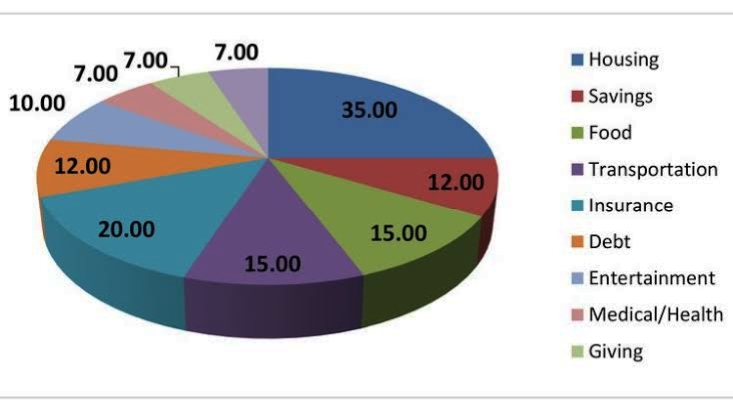Last updated Apr. 17, 2024 by Jessica Green
If you think your meager salary does not require the use of budgeting rules like the 50-30-20 rule, you’re entirely wrong!
The 50-30-20 budgeting rule is not only reserved for the rich or people with good salaries. Regardless of how much you earn or your financial situation, this budgeting rule will work for you.
If you’re new to it and need guidance on what it is, how it works, and examples using real-life scenarios, this article is for you. Read on!
What is the 50/30/20 rule?
The 50-30-20 is a rule of thumb for most people during budget planning. It is straightforward and makes budgeting simple.
The rule suggests dividing your expenses into three categories – needs, wants, and savings or debt repayment. Once your expenses are categorized, allocate a certain percentage of your after-tax income to each category.
According to the 50-30-20 rule, your needs should take up 50% of your after-tax income, 30% should go towards wants, and the last 20% should be saved or used to settle debts.

Here’s a detailed information on what the 50-30-20 rule entails:
50 Percent To Needs
Needs include expenses that are necessary and important for survival. So list out all your needs and allocate half of your income to it.
Most of the expenses that take up this category are indispensable, hence it’s only necessary that 50% of your income goes towards it.
If 50% of your income cannot cover your needs, find ways to cut down expenses. Use coupons during grocery shopping and take advantage of cashback.
Some of the expenses to be included in the ‘Needs’ category include:
Groceries
Car repair and maintenance bills
Utility bills
Health care and insurance
Rent or mortgage payments
30% To Wants
The ‘Wants’ category includes expenses that are not essential for living. An example includes tickets to see a movie or concert, subscriptions to streaming services, eat-outs, gadgets, unnecessary clothes, and travel.
If you enjoy living life to the fullest, the 50-30-20 will be suitable for you since it allocates 30% of your income to fun and entertainment.
20% To Savings or Debt Repayment
After allocating 50% to needs and 30% to wants, the rest of your net income which is 20% should go towards your savings or investment plan.
Here are other things you can spend the 20% on:
Debt Repayment
Emergency Funds
Retirement Contributions (IRA accounts)
Investment accounts
How To Use The 50 30 20 Rule: a step-by-step guide
If you plan on adopting the 50-30-20 rule in your budgeting process, here’s how to get started:

Step One: Calculate Your Net Income
Using your gross income during budget planning can lead you to spend more than you intend to. Thus, it is important to calculate how much you have once tax has been deducted.
If you’re a salaried employee, your net income is the amount that is deposited into your account. But if you’re a freelancer, your net income is your salary minus taxes.
So the first step to using the 50-30-20 rule is to know your take-home pay. If you have multiple sources of income, list them all out and be specific about the exact you make after taxes.
Another Interesting Article: How to Calculate Your Adjusted Gross Income
Step Two: Categorize Your Expenses
The 50-30-20 rule demands that you divide your expenses into three categories – needs, wants, and savings or debt repayment.
So list out all your monthly expenses, and place them in their rightful category. Note, do not mistake a want for a need. For instance, if you can do without spending on a gadget, categorize the gadget as a want. However, if the gadget is important for your work or daily living, it becomes a need.
Request for a statement of account from your bank. The statement should include one to three months worth of transaction. Study the report and split your expenses into three categories.
The needs category should include all the necessary and important expenses you make and the wants category should include spending on fun activities. For the savings category, you can save for retirement, investment, or emergencies.
Step Three: Allocate funds according to the percentage and make adjustments where due
Once you’re done categorizing your expenses, allocate your income according to the 50-30-20 rule.
It’s normal for your expenses to exceed or go below the percentage allocated. In this situation, you’ll need to adjust your expenses to fit the recommended percentage budget.
For instance, if your needs require more than 50% of your income, cut down on certain expenses. However, since most of the expenses under the ‘Needs’ category are indispensable, it can be difficult to cut down. In this situation, focus on cutting down expenses under the ‘Want’ category in order but meet up with expenses under Needs.
Example of the 50/30/20 Budget Rule
To help you better understand the 50-30-20 rule, here’s an example.
Susan works full-time to support her family of three. However, on weekends, she dabbles in freelancing to increase her income.
To develop good money habits and avoid getting into debt, Susan decides to make use of the 50-30-20 budgeting rule.
To get started, she calculates her total take-home income from her full-time and part-time job. Both total $4,000 per month.
Next, she requests a report of her bank statement and begins to analyze it. From the study of the bank report, Susan realizes that she spends about $2,700 on needs, and $1,000 on wants, and barely manages to save $300 every month.
Using the 50 30 20 rule, Susan allocates $2,000 to needs, $1,200 to wants, and $800 for savings. She decides to cut down on the expenses made on needs in order to fit into the 50 30 20 rule.
To avoid eating into her savings and retirement plan, she set up an automatic transfer to her savings account.
Each month, she reviews her expenses and makes changes when due.
Here’s a table that shows Susan’s spending categories:
NEEDS | WANTS | SAVINGS |
|---|---|---|
Food | Data Plan | Emergency Fund |
Utilities (water, electricity, gas) | New clothes | Retirement Contributions |
Health insurance | Streaming services | |
Child’s daycare | Restaurants | |
Transportation | ||
Rent |
Does The 50 30 20 Rule Work?
Yes! The 50 30 20 rule actually works when used probably. It is a simple plan that is suitable for people who want to avoid debt while living their lives to the fullest.
The 50 30 20 rule can work for anyone. However, most people may need to make adjustments to the percentage of the income they spend on a certain category.
Who Is The 50-30-20 Rule For?
The 50 30 20 rule is suitable for people who do not want a strict budgeting plan. It is a budgeting plan that allows you to spend about 30% of your income on things that you like and want – this is very lenient.
The 50-30-20 rule is also for people who have little or no debts. According to the rule, 20% of income goes towards savings or debt repayment. If you’re someone with debts, 20% may not be enough for repayment.
Who Is The 50 30 20 Rule Not For?
The 50 30 20 rule is not suitable for people who need a strict budgeting plan. If you have lots of debts to your name, this plan may not help in clearing off the debts. Go for a budgeting plan like the 30-30-30-10.
As a low-income earner, budgeting 50% of your income for needs may also be unrealistic since essentials take up most of your income.
Another Interesting Article: The #1 Key To A Successful Budget
Pros and Cons of the 50-30-20 Rule
Before you decide to adopt the 50-30-20 rule, here are the pros and cons to look out for:
Pros
1. It is a less strict budgeting plan
Most budgeting rules are strict. However, the 50 30 20 allows you to budget for fun activities under the ‘Want’ category. It also focuses less on savings.
2. It is easy to understand and follow
All you have to do is divide your expenses into three categories and allocate a percentage of your income to each category.
Cons
1.I It doesn’t help pay off debts.
The 50-30-20 allocated only 20% of your income to debt – this may not be enough to meet your monthly debt repayment.
If you want a budgeting plan that enables you to pay off debts faster, do not use the 50-30-20 rule.
2. It gives more to ‘Wants’
The 50-30-20 suggests spending 30% of your salary on wants. This is not recommendable if you have a financial goal to achieve.
3. It is often unrealistic for low-income earners
Household needs often require more than 50% of income. As a low-income earner, the 50 30 20 rule may be difficult to abide by.
4. It promotes wasteful spending
Since the rule suggests spending 30% on wants, it allows high-income earners to spend high amounts on unnecessary things.
5. It does not consider emergency expenses
Emergencies can occur at any time, and you will need funds to settle it. The 50-30-20 rule assumes that your monthly expenses are constant, thus, it does not account for emergencies.
Other Budgeting Rules

Here are other budgeting methods to adopt:
1. The 40 30 20 10 Budgeting Rule
This method is similar to the 50-30-20 rule. It suggests spending 40% of your net income on needs, 30% on wants, 20% on savings, and 10% on debts.
It is most suitable for people without high debts.
2. The 75 15 10 Budgeting Rule
If you need to spend more than 50% of your income on needs, this budgeting rule is suitable for you. It allocates 75% of your income to needs, 15% to wants, and 10% to savings.
Note, that it is not suitable for people with large amounts of debt.
3. The 30 30 30 10 Budgeting Rule
This budget plan is recommendable to people with high-interest debt. It is a strict plan that allows you to reach your financial goals faster.
The 30 30 30 plan allocates 30% to rent or mortgage payments, 30% to necessary expenses, 30% to savings or debt payments, and 10% to wants.
Another Interesting Article: Will the 30-30-30-10 Budget Rule Work for You?
4. The 70 20 10 Budgeting Rule
This plan enables you to save a reasonable amount each month while meeting your daily needs. It directs 70% of your take-home pay to needs, 20% to savings or debt repayment, and 10% to wants.
5. The 60 30 10 Budgeting Rule
This budgeting plan is less restrictive and most suited for people with no pressing financial goal. It allocates 60% of income to needs, 30% to wants, and 10% to savings.
Final Thoughts
Try out the 50 30 20 rule is know if it works for you. If it doesn’t, consider adopting other budgeting methods. Whatever you use, do not underestimate the power of budgeting.
Frequently Asked Questions On Budgeting Rules
Who Came Up With The 50 30 20 Rule?
Elizabeth Warren, a Harvard law professor and Senator, came up with the idea of using the 50 30 20 rule during budgeting in one of her books titled All Your Worth: The Ultimate Lifetime Money Plan
Is the 50 30 20 Rule Still Valid?
Yes! The 50 30 20 budgeting rule is still valid. However, most people use a modified version of it when budgeting.
Which Budget Rule Is Best?
The various budgeting rules work differently for different people. Any rule that works for you is the best.




![Can’t Afford to Live on My Own? [Do These 38 Tips]](https://paypant.com/wp-content/uploads/2024/06/Cant-Afford-to-Live-on-My-Own-Do-These-38-768x512.jpg)


